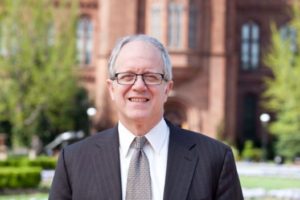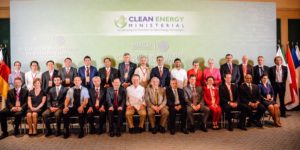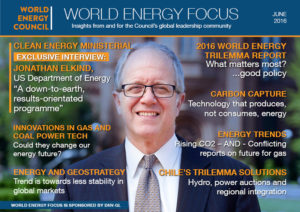
Elkind is Assistant Secretary for International Affairs at the US Department of Energy (DOE), his team runs the CEM secretariat. During the meeting on 1-2 June in San Francisco an already impressive list of activities will be expanded with several new initiatives, including a Corporate Sourcing of Renewables Campaign and an Advanced Cooling Challenge.
“The emphasis of the Clean Energy Ministerial is on accelerating the deployment of technologies that exist in the marketplace right now.” Jonathan Elkind emphasizes that the Ministerial, although it involves the most senior energy policymakers in the world, is above all a down-to-earth, results-oriented programme. He cites many examples of what the CEM has achieved in practice.
Take the SEAD (Super-Efficient Equipment and Appliance Deployment) initiative, a project in which the member countries compared standards and testing protocols for super efficient equipment and appliances. “Each country is different, so there are no one-size-fits-all solutions”, says Elkind. “But by comparing different approaches countries can learn from each other.” In this case, “our colleagues in India picked up on technical work that had been done in the US and used that to develop their own program”, explains Elkind. “The result was that India last year became the first to promulgate a comprehensive standard for LED lighting systems. Then the Indian minister, Piyush Goyal, went a step further and personally ensured that the Indian government started making bulk purchases of LED lamps. In the process, they managed to bring the price down from $4.50 per 9 Watt lamp to just over $1.00.”
The CEM was started in 2009 by then-US Secretary of Energy Steven Chu after the failure of the Copenhagen climate summit. It was one way for the Obama administration to show its determination to tackle the challenge of climate change despite the lack of a global agreement. The strength of the CEM, says Elkind, is the countries that are involved (most major powers, including China, India, Germany, UK, Australia, Brazil, Canada) as well as “the possibilities this presents to learn from each other”. The personal involvement of the energy ministers is also key, says Elkind. “We worked hard to get ministers personally engaged.”

The CEM focuses on where “the biggest opportunities” lie, says Elkind. In this way it is different from Mission Innovation, another initiative from the Obama administration to “accelerate clean energy” around the world. This was signed on 30 November last year in Paris by 20 countries (many of the same as in the CEM) which promised to double their funding for clean energy R&D over the next five years. “The CEM focuses on existing technologies, Mission Innovation on technologies that are just beyond the horizon, or don’t even exist yet”, explains Elkind. The CEM in June in San Francisco will also be host to the first ministerial meeting of Mission Innovation, he adds.
The list of activities that the CEM has undertaken since its inception is long. It includes: the Global Lighting and Energy Acces Partnership (LEAP), the Carbon Capture Use and Storage Action Group, the 21st Century Power Partnership, the Clean Energy Solutions Center, the Electric Vehicles Initiative, the International Smart Grid Action Network, the Multilateral Solar and Wind Working Group, the Bioenergy Working Group, the Sustainable Development of Hydropower Initiative, the Global Sustainable Cities Network and the Global Superior Energy Performance Partnership.
Many of these initiatives are collaborations with other organisations. For example, the CEM solar and wind programme has teamed up with IRENA (International Renewable Energy Agency) to develop the first Global Atlas for Renewable Energy, which presents an overview per country of its renewable energy resources. At first, it showed only wind and solar power resources, but it has now been extended to include marine energy, geothermal, hydropower and bio-energy. “The Atlas provides policymakes with an information base that can help them develop renewable resources by identifying suitable locations”, says Elkind. “Anybody can make use of this – you don’t have to be a member of the CEM.”

The 21st Century Power Partnership is a multilateral platform in which countries look at power system transformation and the new business models utilities will need to adopt to get themselves ready for the clean energy revolution. “No two countries are identically positioned on this, but having these channels creates opportunities for a lot of peer-to-peer learning.”
In the Carbon Capture Use and Storage Action Group, the US works closely with China to bring down the cost of CCS, says Elkind. “None of the credible projections that we have seen show us being able to address the climate challenge unless we see significant cost reductions in CCS. So that’s what we are aiming to achieve.” The US also works with China on energy efficient buildings, Elkind adds.
As if all this is not enough, the meeting in San Francisco will see a number of new campaigns being launched, if the Ministers agree to them. They include the Corporate Sourcing of Renewables Campaign, which will encourage companies to source their power from renewable energies, the Advanced Cooling Challenge, which will help countries deploy super-efficient, smart and affordable cooling and a new Energy Management Campaign.
Although the CEM is an initiative of the Obama administration, Elkind is convinced that it has sufficient appeal to people from a wide political spectrum to see it maintained under a new Administration.
Nevertheless, the secretariat of the CEM will soon be moved from the US Department of Energy to “an international energy institution”, says Elkind, “to ensure that the foundation of the CEM will remain strong and stable.” The ministers will take a decision on this at the San Francisco meeting.
The Office of International Affairs which Elkind heads is not just concerned with clean energy, but also with conventional energy markets. How does Elkind see the clean energy revolution affect geopolitical energy relations? “We see good opportunities for a favourable impact”, he says. “There are going to be a wide variety of different energy solutions available, both distributed and centralised. We believe that having these additional, cost-effective competitive energy choices available to people around the world will enhance energy security both in the US and globally.”
He adds that “our work is motivated by economic and environmental concerns, not by geopolitical considerations, but if the growth of clean energy has the effect of reducing the ability of parties to exert political influence through energy markets, then that’s fine. Let the chips fall where they may.”
Elkind finally notes that it is critical for people to realise “the scope of the challenge and the opportunity that climate change brings.” Different places, he notes, will find different solutions. “Some US states build new nuclear power, others go for renewables. Countries will also make their own choices.”
And the private sector should be closely involved.
For more information see http://www.cleanenergyministerial.org/
ENDS
Jonathan Elkind serves as the Assistant Secretary for the Office of International Affairs (IA) and previously served as the Principal Deputy Assistant Secretary. Prior to joining the Energy Department, he worked as a senior fellow at the Brookings Institution, focusing on energy security and foreign policy issues. From 1998 to 2001, Elkind served on the staff of the U.S. National Security Council as Director for Russian, Ukrainian, and Eurasian Affairs. Between 1989 and 1998, he served in a variety of other government positions on the National Security Affairs staff of the Vice President of the United States, at the U.S. Department of Energy, and at the Council on Environmental Quality.
To read the full June 2016 issue, register at www.worldenergyfocus.org – it’s free.

2016 WORLD ENERGY TRILEMMA REPORT - What matters most? ...good policy! Focused, well-designed energy policy in a robust regulatory environment is the key for countries to achieve the goals of energy security, sustainability and affordability.
INNOVATIONS IN GAS AND COAL POWER TECH - Could they change our energy future? Two new technologies have been announced in the US in recent weeks which have the potential to revolutionise the electricity sector.
CCS - Technology that produces, not consumes, energy
ZERO CO2, GAS-FIRED POWER STATION
ENERGY TRENDS - Rising CO2 – AND - Conflicting reports on future for gas
ENERGY AND GEOSTRATEGY - Trend is towards less stability in global markets
CHILE’S TRILEMMA SOLUTIONS : Hydro, power auctions and regional integration





